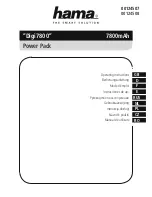
Heat gun
EN
7
6
OPERATION
NOTE:
Before using the tool, read the
instruction book carefully.
PUTTING INTO OPERATION
1. SWITCHING ON/OFF (See Fig. A)
Switching on:
To put into operation, slide the switch (3) to
position
I, II
or
III
.
Switching off:
To switch off, slide the on/off switch (3) to the
stop at position 0.
After working for a longer time with high
temperature, allow the unit to cool by running
in the cold air setting I before switching off.
2. THERMO-PROTECTION SWITCH-OFF
When the heater is overloaded (e.g. as a result
of restricted air flow), the unit switches it off
automatically, however, the blower continues
to run. When the unit has cooled to operating
temperature, the heater is switched on again.
3. SETTING THE AIR FLOW AND
TEMPERATURE
The switch (3) can be set to three blower
steps. Suitable air flow and temperature
combinations can be selected according to the
applications.
Step
temperature
Airflow
I
50
o
C
300L/min
II
350
o
C
300L/min
III
580
o
C
500L/min
The cold air setting
I
is suitable for cooling a
warmed work piece or for the drying of paint.
It is also suitable for cooling the unit before
placing down or the changing of nozzles.
The air setting
II
is suitable for Bending Plastic
and heating shrinking plastic.
The air setting
III
is suitable for stripping paint
and defrosting pipes.
4. WORKING EXAMPLES
Temperature settings given in the application
examples are suggested values that,
depending on the material characteristics, can
deviate. The distance between the nozzle and
work piece is dependent on the material to be
processed.
The ideal temperature should first be
ascertained by performing a test. Therefore,
begin with a lower temperature setting.
All application examples (except
Removing
Paint from Window Frames
) can be
performed without accessories. However,
the use of the recommended accessory part
simplifies the work and significantly improves
the quality of the results.
_ Be careful when changing the nozzle, danger
of burning!
Do not tough the hot nozzle.
Allow the unit to cool. Wear protective
gloves.
5. SCRAPER (See Fig. B)
The scraper is ideal for stripping paint from
flat wooden surface and edges.
Remember to clean the blade after use with
wire wool and lightly oil before storing.
6. REMOVING PAINT
Choose the required nozzle and fit onto the
heat outlet. Soften the paint using hot air and
remove evenly using a spatula. Do not heat
the paint for too long since this will burn the
paint, making it more difficult to remove.
7. REMOVING PAINT FROM WINDOW
FRAMES
Danger of glass breaking!
Use of the glass protection nozzle is essential.
On profiled surfaces, paint can be removed
using a spatula and brushed off using a soft
wire brush.
8. DEFROSTING FROZEN PIPES
Water lines often do not differ in
appearance from gas lines. Gas
lines are not to be heated under any
circumstances.
Place on the reflector nozzle. Heat the frozen
zone always from the outside to the middle.
Warm plastic pipes as well as connections
between pipe pieces especially carefully to
prevent damage.








































